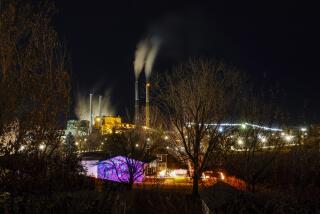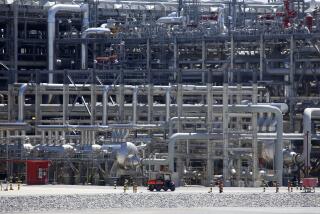Dirty but essential -- that’s coal
- Share via
Standing in the dispatch office of the North Antelope Rochelle Mine near Gillette, Wyo., Scott Durgin pointed at a flat-panel display. The regional vice president for Peabody Energy smiled. The most productive coal mine in the world was on target. Since midnight, about one train an hour had been loaded, each carrying about 16,000 tons of coal.
I asked Durgin how long Peabody could continue mining in the region. Easily for five more decades, he replied. “There’s no end to the coal here.”
The Peabody mine, along with the about 1,300 other coal mines in the U.S., is being threatened. The Environmental Protection Agency has proposed a rule that, if enacted, would in effect outlaw the construction of new coal-fired power plants in the United States. The EPA’s motives are clear: It wants to shut down coal plants, which emit lots of carbon dioxide.
But the EPA and the Obama administration know their attack on coal is little more than a token gesture. The rest of the world will continue to burn coal, and lots of it. Reducing the use of coal in the U.S. may force Americans to pay higher prices for electricity, but it will have nearly no effect on climate change.
There’s no denying that coal has earned its reputation as a relatively dirty fuel. On one particularly nasty day in London in 1812, a combination of coal smoke and fog became so dense that, according to one report, “for the greater part of the day it was impossible to read or write at a window without artificial light.” About 200 years later, the New York Times reported that in Datong, China, known as the City of Coal, the air pollution on some winter days is so bad that “even during the daytime, people drive with their lights on.”
Air pollution is only part of the coal industry’s toll. It damages the Earth’s surface with strip mines, mountaintop removal and ash ponds at power plants. In addition, thousands of workers die each year in coal mines.
But U.S. policymakers are mostly focused on carbon dioxide. The proposed EPA rule would cap the amount of CO2 that new fossil-fuel electricity generation units could emit at 1,000 pounds per megawatt-hour. Absent “carbon capture and storage,” a process that isn’t commercially viable, that standard will rule out coal-fired units, which emit about 1,800 pounds of CO2 per megawatt-hour. (Natural gas units emit about 800 pounds per megawatt-hour.)
Prohibiting new coal-fired power plants may please President Obama’s domestic supporters, but it would leave global coal demand and CO2 emissions almost unchanged. Indeed, over the last decade, even if CO2 emissions in the U.S. had fallen to zero, global emissions still would have increased.
Consider Vietnam, where electricity use increased by 227% from 2001 to 2010. Its coal demand jumped by 175% during the same period, and it had the world’s fastest percentage growth in CO2 emissions. Meanwhile, China has about 650,000 megawatts of coal-fired electricity generation capacity (more than twice the capacity in the U.S.), and it plans to build an additional 273,000 megawatts of coal-fired capacity.
Those numbers help explain this fact: Over the last decade, global coal consumption has increased by more than the growth in oil, natural gas and hydro and nuclear power combined.
We needn’t look only at developing countries to see the essential role of coal. After the disaster at Japan’sFukushima nuclear power plant, Germany is rushing to shutter its reactors. Although renewable-energy projects are the darling of European politicians, nearly 14,000 of the 36,000 megawatts of new electricity generation capacity that will be built in Germany over the next few years probably will be coal-fired facilities.
Coal is helping meet the world’s electricity demands for a simple reason: It’s cheap, thanks to the fact that deposits are abundant, widely dispersed, easily mined and not controlled by any OPEC-like cartels. According to theU.S. Department of Energy, from 1999 through 2010, coal cost about half as much per BTU as the next cheapest fuel, natural gas.
And coal will continue to be a low-cost option. ExxonMobil predicts that in 2030, the cheapest form of electricity production will remain coal-fired generation units, with a total cost of about $0.06 per kilowatt-hour, less than the cost of electricity produced by natural gas, nuclear, wind or solar photovoltaic panels.
Low cost isn’t the only reason for coal’s dominance. Another is “power density,” a measure of the energy flow that can be harnessed from a given area of land. Let’s return to the North Antelope Rochelle Mine. Once you account for the energy lost during the conversion of coal to electricity, the mine yields the equivalent of about 300,000 barrels of oil a day. Solar and wind energy, meanwhile, provided the U.S. with the equivalent of 203,000 barrels of oil a day in 2011. So a single coal mine produces about 50% more energy on an average day than all of the country’s solar panels and wind turbines combined. Moreover, the mine covers just 80 square miles, while domestic wind projects alone cover about 9,400 square miles.
Natural gas and nuclear are potentially better alternatives to coal. Both are able to produce large quantities of reliable electricity, and both have lower CO2 emissions than coal does. Supplies of natural gas are increasing thanks to successful exploration and the shale revolution. Nuclear energy is also seeing significant growth. But neither is growing fast enough to displace coal any time soon. Natural gas production would have to more than double, which will require decades of sustained and expensive exploration and production. Nuclear energy is hampered by huge start-up costs, and many countries don’t have the infrastructure or human capital to support it.
Since the days of Thomas Edison, the United States has relied on abundant supplies of domestic coal to produce electricity, the currency of modernity. We may not like operations such as the North Antelope Rochelle Mine or the generators that burn the fuel it produces. But given the world’s insatiable demand for electricity — and the wealth- and health-enhancing opportunities that come with cheap, abundant, reliable supplies of electrons — it’s obvious that coal will be powering the global economy for decades to come.
Robert Bryce is a senior fellow at the Center for Energy Policy and the Environment at the Manhattan Institute. This essay was adapted from the summer issue of City Journal.
More to Read
A cure for the common opinion
Get thought-provoking perspectives with our weekly newsletter.
You may occasionally receive promotional content from the Los Angeles Times.










